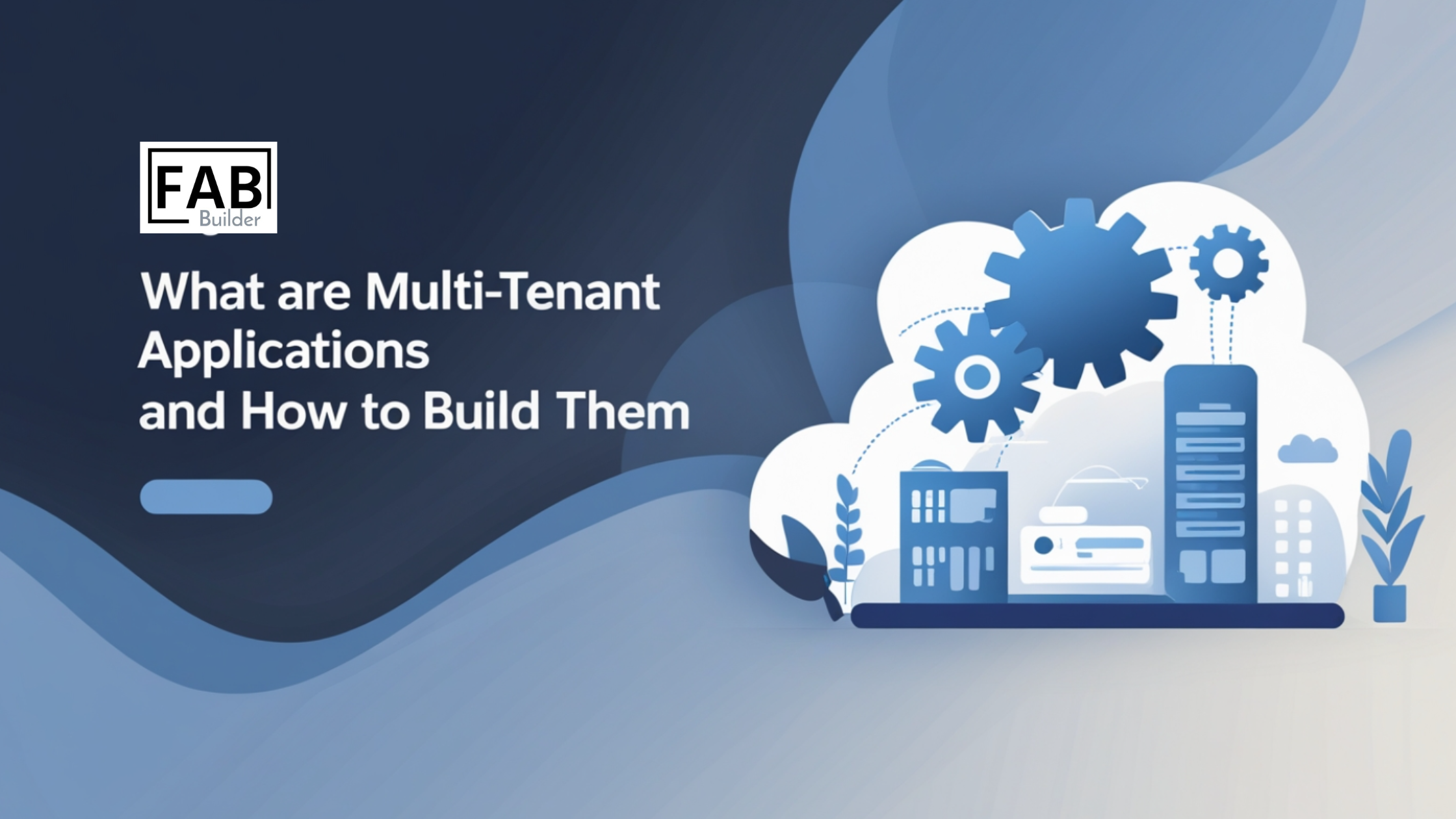What Are Multi-Tenant Applications and How to Build Them?

Why build ten different apps when you can just build one smart enough to handle everyone? Multi-tenant applications are like that one overachiever in school who somehow managed to ace exams, win debates, and still have time for sports — except here, the prize is scalability, cost savings, and happy clients.
Instead of draining your resources creating separate versions of the same software for every client (because who has the time for that?), multi-tenancy lets you run a single application that cleverly serves multiple customers — or tenants — while keeping their data safely tucked away from each other. It’s like having one massive apartment building where every tenant gets their own lock, privacy, and utilities, but you only build the building once.
And here’s where things get even more exciting: pair this with a low code platform like FAB Studio, and suddenly, you’re not just building smarter — you’re building faster, easier, and way more efficiently. In this guide, we’ll break down what multi-tenant applications really are, why they’re secretly the MVP of modern software, and how you can build them without losing your sanity.
What Are Multi-Tenant Applications?
A multi-tenant application is a single software instance designed to serve multiple clients or tenants. Each tenant’s data and configurations are kept isolated, even though they share the same underlying infrastructure and codebase.
To put it simply, imagine an apartment building where each tenant has their own unit. While everyone lives in the same building and uses common facilities like electricity, elevators, and water supply, each apartment remains private and secure. Similarly, in a multi-tenant application, tenants share the core system but maintain their own unique settings and data.
Key characteristics of multi-tenant applications include:
- Shared resources: One application instance serves multiple tenants.
- Data isolation: Each tenant’s data is kept private and inaccessible to others.
- Customizable experiences: Tenants can tailor features such as branding, workflows, and user permissions.
- Scalability: Adding a new tenant requires minimal overhead compared to deploying a new application instance.
Why Multi-Tenant Architecture Matters in Modern Software Development
The growing adoption of SaaS (Software-as-a-Service) has made multi-tenancy a necessity. Companies no longer want to manage individual software installations for each client. Instead, they prefer centrally managed, cloud-hosted solutions that can scale quickly.
Benefits of multi-tenant applications include:
- Reduced Costs: By maintaining a single codebase and infrastructure, businesses save significantly on resources.
- Simplified Maintenance: Updates, patches, and upgrades can be rolled out to all tenants simultaneously.
- Faster Onboarding: New tenants can be provisioned quickly with minimal setup.
- Better Resource Utilization: Shared infrastructure ensures efficient use of computing power and storage.
- Scalability at Scale: Multi-tenant apps can seamlessly handle growth in user base without redesigning architecture.
The Role of Low Code Platforms in Multi-Tenant Application Development
Traditional software development often requires complex coding and manual configuration to achieve multi-tenancy. However, a low code platform like FAB Studio revolutionizes this process by providing visual interfaces, pre-built components, and automation tools that accelerate development.
By leveraging a code generator and an AI code builder, businesses can quickly design applications that are not only multi-tenant but also scalable, secure, and customizable.
Advantages of building multi-tenant apps on a low code platform include:
- Speed: Rapid prototyping and faster deployment.
- Accessibility: Enables both technical and non-technical users to collaborate in development.
- Flexibility: Easy integration with third-party services.
- Consistency: Centralized management reduces errors and inconsistencies across tenants.
What are the Key Considerations When Designing Multi-Tenant Applications
To build a robust multi-tenant system, developers must focus on several architectural and operational elements.
1. Data Isolation
Tenant data must be isolated to ensure privacy and security. This can be achieved using:
- Separate databases per tenant (higher security, more cost).
- Shared database with tenant identifiers (more scalable, cost-effective).
2. Authentication and Authorization
Each tenant should have secure login systems and role-based access control. This ensures that users only access what they are authorized to see.
3. Customization and Branding
Allow tenants to customize the look, feel, and workflows of the application without affecting other tenants. For example, they might want custom dashboards, branding elements, or feature configurations.
4. Performance Optimization
Since multiple tenants share the same resources, performance tuning and load balancing are critical. Proper caching, database indexing, and optimized queries help maintain efficiency.
5. Security and Compliance
Multi-tenant systems must adhere to strict compliance standards like GDPR, HIPAA, or SOC 2 depending on the industry. Encryption of data at rest and in transit is essential.
What are the steps to Build Multi-Tenant Applications Using a Low Code Platform
Step 1: Define Tenant Model
Decide how tenants will be managed within the system. Choose between:
- Shared schema with tenant IDs.
- Separate schemas per tenant.
- Separate databases for each tenant.
Step 2: Design Scalable Architecture
Use microservices or modular design to ensure easy scalability. A well-structured application development platform enables scaling without downtime.
Step 3: Implement Secure Authentication
Leverage OAuth, SAML, or other identity providers to ensure secure tenant onboarding and access.
Step 4: Build with Code Generators
Platforms like FAB Studio provide code generation platforms and AI code generators that reduce manual coding efforts, automatically generating secure and efficient multi-tenant frameworks.
Step 5: Add Tenant-Level Customization
Introduce configurable modules for branding, access controls, and feature toggles so each tenant can tailor the app to their needs.
Step 6: Ensure Monitoring and Analytics
Use tenant-aware monitoring tools to track usage, performance, and errors at the tenant level. This ensures proactive support and continuous improvement.
Step 7: Deploy and Maintain Efficiently
Deploy the application in cloud environments that support elastic scaling. Regular updates and patches should be automated to ensure all tenants benefit simultaneously.
What Are the Challenges in Building Multi-Tenant Applications?
Despite their advantages, multi-tenant applications also present certain challenges:
- Complex Security Requirements: Ensuring strict isolation between tenants can be difficult.
- Data Migration: Moving tenants from one infrastructure to another can be resource-intensive.
- Performance Bottlenecks: Poor optimization may cause slower response times for all tenants.
- Customization Balance: Offering too much customization can complicate the system.
Using a low code platform can significantly reduce these challenges by providing pre-tested frameworks and built-in best practices for multi-tenancy.
What Is the Future of Multi-Tenant Applications?
With businesses increasingly adopting SaaS models, multi-tenant applications will continue to dominate. The rise of AI code generators and intelligent code builders is making it easier to design secure, scalable, and tenant-aware apps. Platforms like FAB Studio are leading the way by combining low code development with automation, enabling enterprises to innovate faster while keeping costs under control.
Conclusion
Multi-tenant applications are transforming the way software is developed, deployed, and consumed. They allow businesses to serve multiple clients with one powerful, scalable, and secure solution, drastically reducing costs while improving efficiency. By adopting a low code platform like FAB Studio, companies can accelerate the development process, minimize errors, and deliver high-quality applications tailored to diverse tenant needs.
Organizations that invest in multi-tenant architecture today are better positioned to succeed in the highly competitive SaaS market of tomorrow.
Frequently Asked Questions (FAQs)
1. What is a multi-tenant application?
A multi-tenant application is a software system where one application instance serves multiple customers, with each tenant’s data securely isolated.
2. Why should businesses use a multi-tenant architecture?
It helps reduce costs, ensures scalability, simplifies maintenance, and allows centralized updates for all users.
3. How does a low code platform help in building multi-tenant apps?
A low code platform speeds up development by providing pre-built components, visual workflows, and scalable frameworks for multi-tenancy.
4. What is the role of a code generator in multi-tenant applications?
A code generator automates repetitive coding tasks, reduces errors, and accelerates the development of secure and scalable applications.
5. Can multi-tenant applications be customized for each tenant?
Yes, while the core codebase is shared, tenants can personalize features, interfaces, and settings without affecting others.
- Art
- Causes
- Best Offers
- Crafts
- Dance
- Drinks
- Film
- Fitness
- Food
- Παιχνίδια
- Festival
- Gardening
- Health
- Κεντρική Σελίδα
- Literature
- Music
- Networking
- άλλο
- Party
- Religion
- Shopping
- Sports
- Theater
- Wellness



